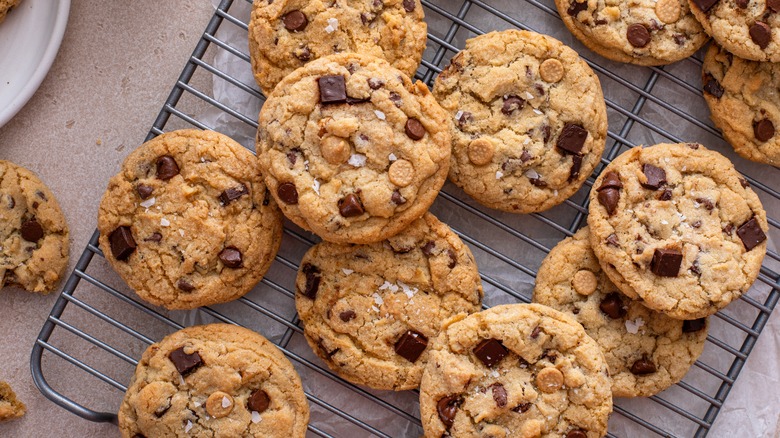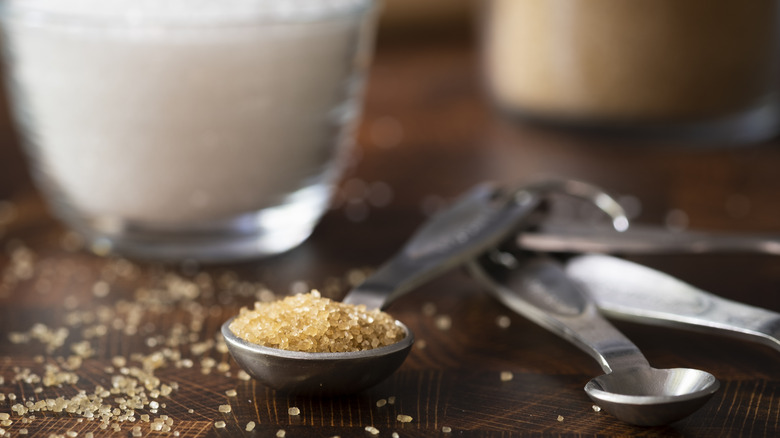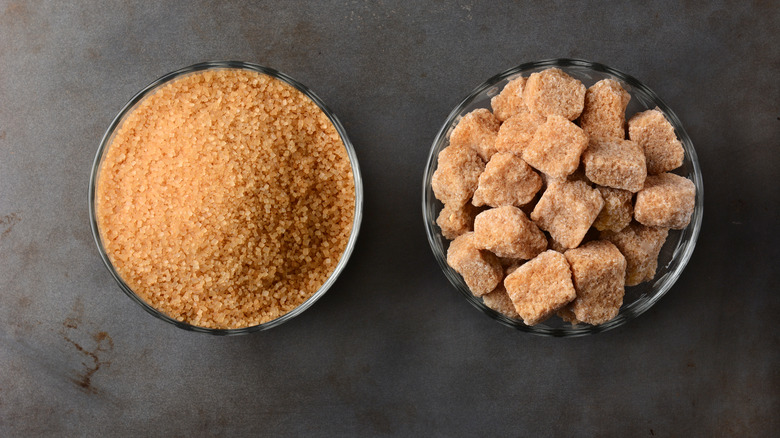Enhance The Texture And Flavor Of Your Cookies With One Ingredient
For the chewiest cookies, you'd skip the granulated sugar; for the crispiest ones, you'd skip the step of refrigerating the dough. But what happens when you want cookies that are somewhere in between — gooey and pliant under your fingers but with just a hint of crunch in each bite? How do you get that contrast of crunchy chewiness in each mouthful? The answer is in a spoon or two of turbinado sugar!
There are all kinds of sugar that you could use in baking, but what gives turbinado (aka raw sugar) an edge is its texture and flavor. Turbinado sugar is made by boiling the syrupy liquid produced from the very first pressing of sugarcane, which is then slowly allowed to evaporate until only crystals remain. At first glance, these crystals might resemble brown sugar, but upon closer inspection, you'll find that they are larger, thicker, and pack a richer flavor.
Turbinado sugar is less processed than its granulated counterpart. Because of this, it contains a greater amount of the flavor and molasses that is naturally present in sugarcane than white or brown sugar does. More importantly, it doesn't dissolve as smoothly in liquids, which though not always a good thing, can be a welcome addition to cookies. These granules will hold their shape in the dough, giving your cookies a delicate crunch and a rounded toffee-like flavor.
What to keep in mind when using turbinado sugar
Turbinado can be added to any bake — including cookies — by simply scaling back some of the other sugar in the recipe. For instance, if the cookies call for four tablespoons of white sugar, replace one or two of those with turbinado depending on how much crunch you want.
Technically, you could even replace all the white or brown sugar in a recipe with equal parts of turbinado. However, there are a few things to keep in mind when doing so.
For one, it's important to consider turbinado's larger granule size when measuring it as you might end up with much less than intended. But the biggest factor is turbinado's water content: It has less moisture than brown sugar but more than white. Brown sugar contains added molasses, which gives it more moisture. This, in turn, yields denser, softer, and chewier bakes. When substituting all of the brown sugar with turbinado, you'll have a more brittle and crumbly bake.
On the flip side, turbinado will add extra moisture when swapped with white sugar. While the difference may not be significant in already wet batters, it might ruin a bake that banks on dry dough. But if it's just that hint of crunch and caramel-like flavor that you want from turbinado instead of its sweetening power, it might be best to swap it with only a few spoonfuls.
Ways to use turbinado sugar beyond cookies
Once you know just what turbinado can bring to the table and how to swap it into any recipe, you will find that cookies are just the beginning of this sugar. Turbinado can be added to any soft bake that could do with a slight textural contrast — think brownies, loaves, and even cakes.
One of the best ways to use it in cookies and beyond, however, is as a finishing sugar. Sprinkle it on top of cobblers, muffins, puddings, pies, and the like before popping them in the oven. The sugar will caramelize in the heat without fully melting, giving the bakes a toffee-flavored crunch on top. But why stop just at bakes? Dust it onto yogurts, smoothie bowls, pancakes, oatmeal, and just about anything that could do with its coarse texture and candied flavor.
Besides, turbinado can even be added to savory marinades and meat rubs or used as a rim for cocktails — after all, it won't dissolve as you slowly slip the liquid. As long as you don't add it to foods like velvety sauces and fluffy whipped cream that need to be smooth, the possibilities for turbinado sugar are endless.



